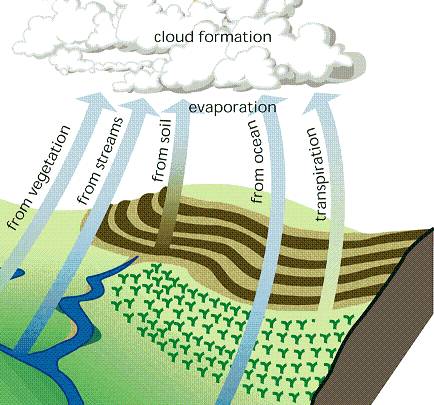Competency Area 2: Soil hydrology AEM
PO 11. Understand factors that affect:
- Soil Infiltration
- Evaporation and Transpiration
- Leaching
- Runoff
- Soil Water Storage
Evaporation and Transpiration
The primary factors that affect the potential evaporation and transpiration, if water is readily available from soil and plant surfaces, are:
- Solar Radiation and Temperature
- Humidity and Wind
Solar radiation and temperature are the thermal (radiation and sensible heat energy) sources that cause water to evaporate from the earth's surface. The amount of heat energy needed to cause water to pass from a liquid to a gaseous state is called the latent heat of vaporization.
For a clear sky in the Northeast on the first day of summer, the maximum incoming (extraterrestrial) solar radiation potential provides enough energy to evaporate about a half inch of water per day. However, some of this solar energy is absorbed and diffused by clouds, some is reflected from soil, water, and plant surfaces (the albedo), and some goes into heating the atmosphere and the soil.
A heavy cloud cover in the lower atmosphere can significantly affect the amount of solar radiation that reaches the earth's surface. Since the incoming extraterrestrial solar radiation energy is reflected and diffused as it passes through the atmosphere, the net radiation potential reaching the earth's surface is much less. At the earth's surface, the potential evaporation and transpiration is about half to two-thirds the maximum, or generally around one-fourth inch of water per day when summer begins.
Humidity (vapor pressure) and wind are the aerodynamic forces which influence evaporation and transpiration. Humidity affects the vapor pressure gradient of the atmosphere and wind mixes and alters the vapor pressure gradient. At 100% humidity the atmosphere is saturated with as much water vapor as it can hold, so high humidity has the effect of reducing the amount of evaporation and transpiration that occurs. If there is no wind, the water vapor is not transported away from the evaporating or transpiring surface. We feel these same effects as we desire more water on a clear, hot, low humidity, windy day compared to a cloudy, cool, high humidity, still day

Illustration by Tom Schultz Courtesy of Iowa State University Department of Natural Resource Ecology and Management http://www.h2owell.com/hydro_cycle_pic.htm
Quick Links
- Competency Area 1: Basic soil properties
- Competency Area 2: Soil hydrology AEM
- Competency Area 3: Drainage and irrigation AEM
- Competency Area 4: Soil health and compaction
- Competency Area 5: Soil conservation AEM
- Competency Area 6: Watershed hydrology AEM
- Competency Area 7: Non-point source pollution AEM
- Competency Area 8: Concentrated source pollution AEM
- Competency Area 9: Conservation planning AEM
